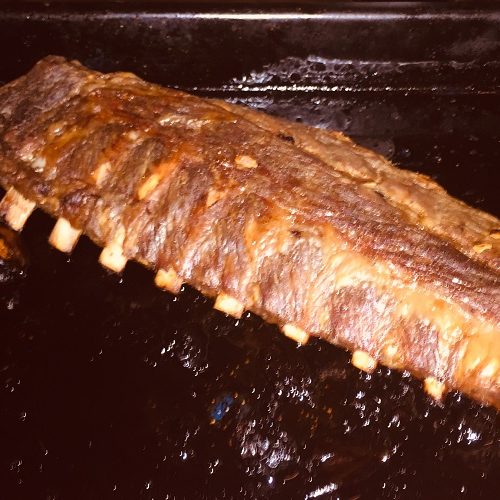
Grill-Smoked Meat (Carne de chango)
Now that I live in an apartment with no outdoor grill, I often substitute baby back ribs. I let it marinate for a few hours or overnight in the pan that I will be roasting them in. When ready to cook, I add about 2 cups water and cover the pan tightly with aluminum foil and cook them at 375ºF for about an hour. Brush marinade onto the ribs, and cook until browned and glazed, about 30-40 minutes.
Ingredients
For marinating:
- 2 pounds boneless pork loin in one piece trimmed of nearly all surface fat
- 1 teaspoon coarse salt
- 1 teaspoon freshly ground black pepper
- ¾ cup freshly squeezed lime juice
- 10 cloves garlic crushed
For frying the meat:
- 3 tablespoons lard, preferably
home-rendered or vegetable oil
Instructions
- Cut the meat crosswise into sections about 3 inches long (the number of pieces will depend on the shape of the meat you start out with). With a very sharp, thin-bladed knife (see above), score a shallow (about ¼-inch deep) cut lengthwise along one piece. With the blade held lengthwise, begin to cut as if you were peeling an apple or potato — but instead of removing the outer layer, the object is to carve an entire piece into one long sheet-like strip about ¼-inch thick. Repeat with the rest of the meat.
- Rub the meat all over with salt and pepper. Combine the lime juice and garlic in a shallow, non-reactive dish such as a large glass baking dish. Add the meat, turning to moisten on all sides. Let sit, covered, turning the meat occasionally for 2–3 hours in the refrigerator.
- About 30 minutes before you are ready to smoke the meat, soak about 3 cups wood chips in 1 quart of water. (You may need to add a little more water from time to time.) If you have a smoker-grill, set it up and light by the manufacturer’s directions. Otherwise, do as I did with a standard kettle-type grill: Mound about 15 large pieces of good hardwood charcoal (commercial briquets will not do) on the left side of the grill and place a medium-sized metal container with water on the right side. Position the rack about 6 inches above the coals. Light the coals, preferably using an electric coil chimney starter. (Lighting fluids are the means of last resort — most leave an awful kerosene smell in the air.)
- Let the coals burn until red-hot all over, then add about 1 cup of the soaked wood chips to the coals. Close the lid and open a top vent just enough to insert a candy thermometer 5 inches into the chamber. Pull it out at frequent intervals to check the temperature. When it reaches 200ºF, remove the meat from the marinade and blot dry with paper towels. Open the lid, quickly place the meat on the rack over the water dish, and close the lid. (Any meat drippings will fall into the water rather than making a lot of acrid smoke as they hit the hot coals.) The meat must smoke about 40 minutes at a temperature between 185ºF-200ºF. Watch carefully, pulling out the thermometer periodically to check and occasionally feeding in another handful of wood chips. If you see the thermometer dipping below 185ºF, add another coal to the fire. If it starts getting too hot, open another of the vents for 2-3 minutes. Turn the meat halfway through the cooking. It is done when it takes on a light reddish tint.
- The carne de chango can be fried at once or stored, covered, in the refrigerator for up to a week. When you are ready to serve it, heat the lard or oil over medium-high heat in a large heavy skillet. When it ripples, quickly flash-fry the meat on both sides, allowing about 1-2 minutes in all. The strips can be cut into large individual serving pieces to be eaten with a knife and fork, or into ½- to 1-inch pieces to be used as a taco filling.
Nutrition
Calories: 414kcalCarbohydrates: 7gProtein: 52gFat: 20gSaturated Fat: 11gCholesterol: 143mgSodium: 695mgPotassium: 938mgFiber: 1gSugar: 1gVitamin A: 26IUVitamin C: 16mgCalcium: 34mgIron: 1mg